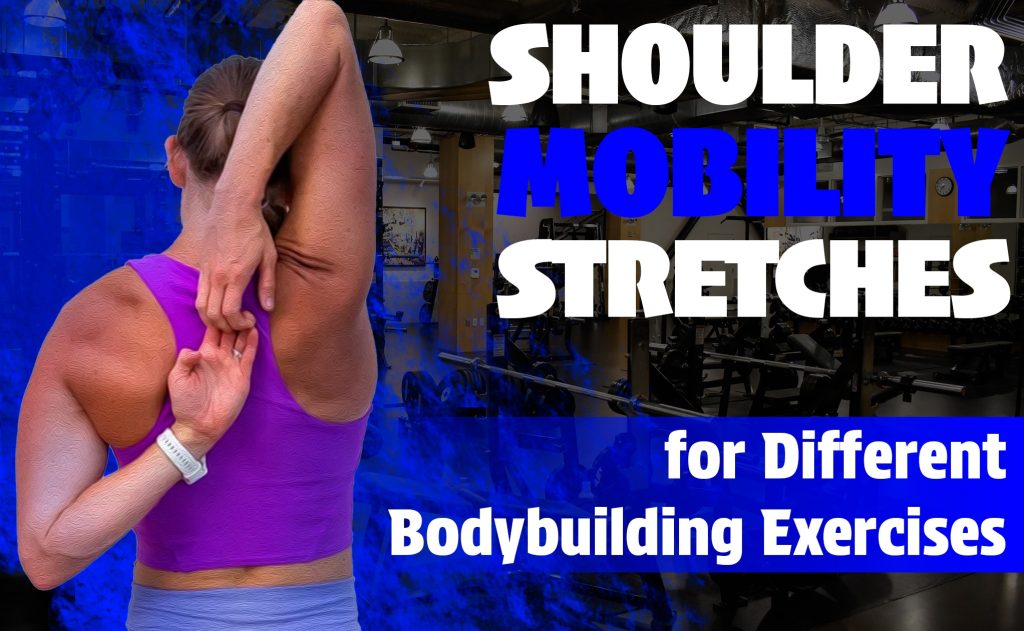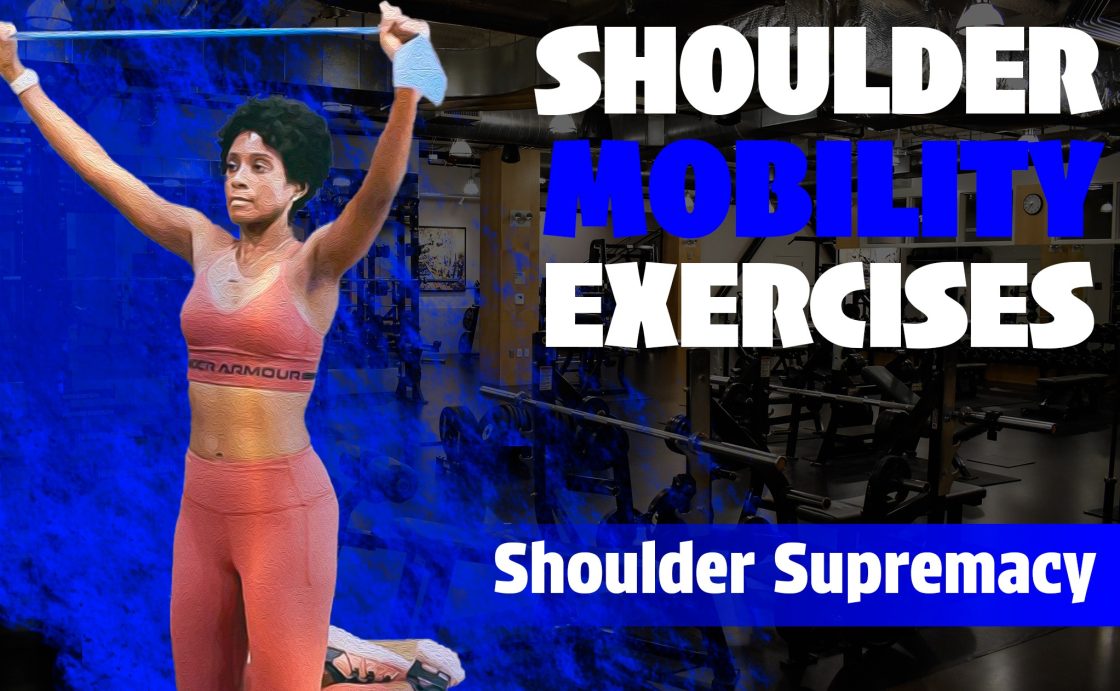Whether you’re a beginner or a seasoned lifter, these simple yet powerful techniques will help you enhance your range of motion, master challenging exercises like bench presses and overhead presses, and achieve the shoulder supremacy you’ve always desired. Get ready to elevate your training and take your bodybuilding game to new heights with these shoulder mobility exercises.
Understanding Shoulder Anatomy
The shoulder muscles can be divided into three categories: the deltoid muscles, the rotator cuff muscles, and the scapular stabilizers.
Deltoid Muscles
The deltoid muscles are located on the outermost part of the shoulder and consist of three distinct parts: the anterior (front), middle, and posterior (rear) deltoids.
- These muscles are responsible for various movements of the shoulder joint, such as lifting the arm forward, to the side, and backward.
Rotator Cuff Muscles
These muscles include the following: infraspinatus, supraspinatus, teres minor, and subscapularis.
- The rotator cuff muscles are a group of four muscles that surround the shoulder joint and work together to stabilize and control its movements.
- The rotator cuff muscles play a vital role in maintaining the proper alignment of the humeral head within the shoulder joint, preventing impingement, and providing stability during movement.
Scapular Stabilizers
These muscles include the trapezius, rhomboids, and serratus anterior. The scapular stabilizers refer to the muscles that control the position and movement of the shoulder blades (scapulae) to maintain proper shoulder alignment.
- The trapezius muscle runs along the upper back and plays a significant role in shoulder elevation and retraction.
- The rhomboids sit between the shoulder blades and are responsible for pulling them together.
- The serratus anterior, located on the sides of the ribcage, assists in protracting and stabilizing the shoulder blades.
Importance of Shoulder Mobility
Shoulder mobility stretches plays a vital role in building overall strength and stability in bodybuilding. The shoulders are involved in many important movements that require stability and control, such as bench presses, overhead presses, and pull-ups. Without adequate mobility in the shoulders, these exercises can become limited and less effective.
- Having good shoulder mobility allows for a greater range of motion in your upper body movements, which means you can engage more muscle fibers and increase your potential for strength gains.
- It also helps to prevent injury by reducing the strain on other muscles and joints. Strong and mobile shoulders contribute to better posture and alignment, which is crucial for maintaining proper form and maximizing the effectiveness of your workouts.
- In bodybuilding, it’s not just about lifting heavy weights; it’s about performing the exercises with precision and targeting specific muscle groups.
- By focusing on improving shoulder mobility, you can enhance your overall performance and build a balanced, symmetrical physique.
Benefits of Proper Shoulder Mobility
Proper shoulder mobility stretches is essential for performing exercises effectively and preventing injuries in bodybuilding. By maintaining good shoulder mobility, individuals can unlock several benefits, including improved exercise performance, reduced pain and discomfort, and better overall shoulder health.
Enhanced Exercise Performance
Proper shoulder mobility is crucial for performing various exercises correctly and with the right form. Without proper mobility, individuals may experience difficulty executing exercises, compromising their ability to engage the targeted muscle groups fully.
By improving shoulder mobility through stretching, mobility exercises, and regular training, individuals can enhance exercise performance, optimize muscle activation, and increase their overall workout effectiveness.
Reduced Pain and Discomfort
Shoulder mobility issues, such as tightness and imbalances, can lead to pain and discomfort in the shoulder joint and surrounding areas. This discomfort can affect exercise performance and overall quality of life if left unaddressed.
By incorporating exercises that focus on improving shoulder mobility, individuals can reduce pain and discomfort in the shoulders and prevent potential injuries. Proper stretching and mobility exercises can help to alleviate muscle tension and joint stiffness, leading to greater ease of movement and less discomfort.
Improved Shoulder Health
Proper shoulder mobility is crucial for maintaining good shoulder health, preventing injuries, and minimizing wear and tear on the joint. By addressing common shoulder mobility issues through appropriate training and maintenance techniques, individuals can improve overall shoulder function and health.
Proper shoulder mobility stretches helps to strengthen the muscles surrounding the joint, improve joint stability, and increase flexibility, reducing the risk of shoulder injuries. Furthermore, by maintaining good shoulder mobility, individuals can enjoy better quality of life, improved athletic performance, and reduced pain and discomfort in the shoulder joint and surrounding areas.
Common Shoulder Mobility Issues
There several common issues can impact shoulder mobility, including tightness, muscle imbalances, and limited range of motion. Understanding these issues is crucial for addressing them effectively and improving overall shoulder function.
Tightness
One of the primary factors that can limit shoulder mobility is tightness in the muscles surrounding the shoulder joint, such as the deltoids, the rotator cuff muscle, and the upper back muscles. Tightness in these areas can restrict the range of motion of the shoulder, leading to poor exercise performance and increased risk of injuries.
- To address tightness in the shoulders, bodybuilders can incorporate stretching exercises that target the shoulder muscles, such as shoulder rolls, doorway stretches, and pec stretches.
Regular stretching helps to improve flexibility, reduce muscle tension, and enhance overall shoulder mobility, allowing for better exercise execution and preventing potential issues.
Muscle Imbalances
Muscle imbalances occur when certain muscle groups are stronger or more dominant than others, leading to asymmetries in strength and function. In bodybuilding, muscle imbalances in the shoulders can affect mobility and stability, making it challenging to perform exercises with proper form and control.
- To correct muscle imbalances in the shoulders, bodybuilders should focus on balancing strength training exercises that target all shoulder muscle groups equally. By incorporating exercises that target the deltoids, rotator cuff muscles, and scapular stabilizers, individuals can improve overall shoulder balance, mobility, and reduce the risk of overuse injuries.
Limited Range of Motion
Limited range of motion in the shoulders can restrict the ability to perform exercises through their full range of motion, affecting muscle activation and overall exercise effectiveness. Factors such as tightness, muscle weakness, and joint stiffness can contribute to limited shoulder mobility and impact workout performance.
- To improve range of motion in the shoulders, bodybuilders can perform dynamic stretches and mobility exercises that focus on moving the shoulder joint through various planes of motion. By incorporating exercises like arm circles, shoulder dislocations, and shoulder rotations, individuals can enhance shoulder flexibility, increase joint mobility, and optimize exercise performance in their training regimen.
Effective Warm-up Exercises
Performing proper warm-up exercises before intense workout sessions is essential for preparing the body and specifically the shoulder joint for the demands of exercise. Incorporating dynamic warm-up exercises can help improve shoulder mobility, increase blood flow, enhance muscle activation, and reduce the risk of injuries.
Arm Circles
Arm circles warm up the muscles surrounding the shoulder joint, increasing blood flow and mobility. This exercise helps to loosen up the shoulder muscles, promote synovial fluid production, and prepare the joint for more intense shoulder exercises.
- To perform arm circles, stand with your feet shoulder-width apart, extend your arms out to the sides at shoulder height, and start making small circles forward.
- Gradually increase the size of the circles, allowing the shoulder joint to move through its full range of motion.
Shoulder Dislocations
Shoulder dislocations dynamically stretch the shoulder joint and surrounding muscles, allowing for improved range of motion and increased flexibility. This exercise is particularly effective in addressing tightness and limited mobility in the shoulders, making it an excellent warm-up exercise before intense shoulder workouts.
- Begin by holding a resistance band or towel with a wide grip in front of your body.
- Slowly raise your arms overhead and behind you, while keeping your arms straight.
- Continue the movement until you feel a stretch in your shoulders, then reverse the motion back to the starting position.
Prone Y’s and T’s
Prone Y’s and T’s activate the muscles in the upper back and shoulders, promoting stability and proper alignment during shoulder exercises. These exercises also help in opening up the chest and improving posture, allowing for better shoulder mobility and reduced risk of injuries during intense workout sessions.
- Start by lying face down on a mat or bench with your arms extended above your head.
- In the “Y” position, lift your arms up and away from your body, forming a Y shape.
- In the “T” position, lift your arms out to the sides, forming a T shape.
- Hold each position briefly, focusing on squeezing the shoulder blades together.
Strengthening Exercises for Shoulder Mobility
Improving shoulder mobility not only involves stretching and mobility exercises but also requires strengthening the muscles that support and stabilize the shoulder joint. Incorporating specific strengthening exercises into your fitness routine can help enhance shoulder mobility.
Push-Ups
Push-ups work the muscles surrounding the shoulder joint, including the deltoids, pectoralis major, and triceps. By strengthening these muscles, push-ups help to provide stability and support for the shoulders, improving overall mobility and reducing the risk of strain or imbalances during movement.
Bent-Over Rows
Bent-over rows target the rhomboids, trapezius, and posterior deltoids, which are important muscles for shoulder stability and mobility. By strengthening these muscles, bent-over rows help to improve posture, promote proper alignment, and enhance the functional strength of the shoulders.
External Rotations
External rotations engage the infraspinatus and teres minor muscles, which are important for stabilizing the shoulder joint. Strengthening the rotator cuff muscles through external rotations can help to prevent and rehabilitate shoulder injuries, enhance shoulder mobility, and improve overall shoulder function.

Shoulder Mobility Stretches for Different Bodybuilding Exercises
Shoulder mobility is crucial in bodybuilding exercises like bench and overhead presses, and lateral raises. To perform these exercises effectively, it’s important to focus on specific shoulder mobility exercises that target the muscles involved.
Shoulder Rotations
One excellent exercise to improve shoulder mobility is shoulder rotations. This exercise involves using a resistance band or broomstick to strengthen and stretch the shoulder muscles. This exercise helps to increase the range of motion in your shoulders and promotes flexibility.
- Start by holding the band or stick in front of you with a wide grip.
- Slowly rotate it in a circular motion, making big circles with your arms.
Prone Angels and Rows
Another effective exercise for shoulder mobility is performing prone angels and rows. These exercises strengthen the muscles in your upper back and shoulders, enhancing stability and mobility in the shoulder joint.
- Lie face down on an exercise bench or mat with your arms extended straight ahead.
- For the angels, lift your arms up and out to the sides, forming a V shape with your body. Hold for a second, then lower your arms back down.
- For the rows, keep your arms straight out to the sides, parallel to the ground, and pull your elbows back, squeezing your shoulder blades together.
Arm Rotations
Arm rotations are a simple yet effective exercise for shoulder mobility. Arm rotations help to warm up and loosen the muscles surrounding your shoulder joint, improving their flexibility.
- Begin by standing with your feet shoulder-width apart and your arms extended straight out to the sides.
- Slowly rotate your arms in small circles, first forward and then backward.
- Start with small circles and gradually increase the size.
- After a few rotations, switch direction and perform circles in the opposite direction.
Doorway Stretch
Don’t underestimate the power of the doorway stretch in improving shoulder mobility. Doorway stretches target the muscles that often get tight from exercises like bench presses, helping to improve flexibility and range of motion in the shoulders.
- Stand in a doorway and place one hand on the doorframe at shoulder level.
- Gently lean forward, allowing your chest to stretch and your shoulder to open up.
- Hold the stretch for about 30 seconds, then switch arms and repeat on the other side.
Wall Slides
Wall slides are another effective exercise for improving shoulder mobility. By incorporating wall slides into your shoulder mobility training routine, you can target the muscles involved in bodybuilding exercises and improve their flexibility. This exercise specifically focuses on the shoulder joint, helping to enhance stability and mobility.
- Stand with your back against a wall, and your feet shoulder-width apart.
- Place your arms against the wall in a goalpost position, with your elbows bent at a 90-degree angle.
- Slowly slide your arms up the wall, keeping your elbows and wrists in contact with the wall as much as possible.
- Once you reach as high as you can comfortably go, slowly slide your arms back down.
Banded Shoulder Mobility Stretches: Boosting Bodybuilding Training
Banded exercises involve using resistance bands to target specific muscles and promote flexibility. Resistance bands come in different strengths, making them perfect for beginners and advanced gym-goers alike. Banded exercises don’t require equipment and can be done anywhere. But their low impact and effective nature make them ideal for warming up, recovery, and enhancing mobility.
Banded Face Pull
- To perform the banded face pull, attach a resistance band to a stationary object at chest height.
- Grasp the band with both hands and step back to create tension.
- While keeping your elbows high and in line with your shoulders, pull the band towards your face.
- Squeeze your shoulder blades together and pause for a moment before returning to the starting position.
- Repeat for the desired number of repetitions.
Banded Pull-Apart
- For the banded pull-apart, stand tall with your feet shoulder-width apart and hold a resistance band in front of you.
- Your hands should be slightly wider than shoulder-width apart.
- With your palms facing down, pull the band apart by squeezing your shoulder blades together.
- Maintain tension in the band and control the movement as you return to the starting position.
- Repeat for the desired number of repetitions.
Banded Internal/External Rotations
To target the rotator cuff muscles, you can perform banded internal and external rotations.
- For banded internal rotations, attach a resistance band to a sturdy anchor point. Stand perpendicular to the anchor with your arm bent at 90 degrees and elbow tucked into your side. Hold the band in your hand and rotate your arm inward, maintaining tension in the band throughout the movement. Return to the starting position and repeat for the desired number of repetitions.
- For external rotations, follow the same setup but rotate your arm outward instead.
Remember to start with lighter resistance bands and gradually increase the tension as your shoulder strength and mobility improve. Perform each exercise slowly and with control, focusing on activating the targeted muscles. Consistency is key, so aim to incorporate banded shoulder mobility exercises into your routine two to three times per week for optimal results.
Correcting Shoulder Mobility Imbalances
Having proper shoulder mobility is crucial for bodybuilders. However, imbalances in shoulder mobility can hinder progress and increase the risk of injuries. Understanding and addressing these imbalances is important to optimize your bodybuilding training.
Identifying Imbalances in Shoulder Mobility
Shoulder mobility imbalances can occur when certain muscles are overly tight or weak, leading to restricted range of motion and poor movement patterns. Some common signs of imbalances include difficulty reaching overhead, pain or discomfort during exercises, and asymmetrical shoulder movement. These imbalances can be caused by factors such as poor posture, muscle imbalances, and previous injuries.
Corrective Exercises for Shoulder Mobility Imbalances
- T-Spine Rotations
T-Spine rotations help improve thoracic spine mobility, which can indirectly impact shoulder mobility.
- Begin by kneeling on all fours with your hands beneath your shoulders and your knees under your hips.
- Place one hand behind your head, keeping your elbow pointing out to the side.
- Slowly rotate your upper body, leading with your elbow, and aim to rotate as far as you comfortably can.
- Return to the starting position and repeat on the other side.
- Perform several repetitions on each side, focusing on smooth and controlled movements.
- Supine Pec Stretch
Tight pectoral muscles can contribute to shoulder mobility imbalances.
- Lie on your back on a foam roller or a rolled-up towel positioned lengthwise along your spine.
- Extend your arms out to the sides, forming a “T” shape, with your palms facing up.
- Allow your arms to relax towards the floor, feeling a stretch in your chest and shoulders.
- Hold the stretch for 30 seconds to one minute while taking deep breaths.
- Release the stretch slowly and repeat as needed.
Strategies for Restoring Balance
In addition to corrective exercises, implementing a few strategies can help restore balance in shoulder mobility:
1. Improve Posture
Proper posture plays a significant role in maintaining balanced shoulder mobility. Be mindful of your posture throughout the day, especially when sitting or standing for extended periods. Focus on keeping your shoulders back and down, maintaining a neutral spine, and avoiding slouching.
2. Stretch and Mobilize Regularly
Incorporate regular stretching and mobility exercises into your routine to prevent muscle imbalances and stiffness. Include exercises that target the shoulders, thoracic spine, and related muscles. Consistency is key for achieving long-term improvements in shoulder mobility.
3. Strengthen Weak Muscles
Identify and target any weak muscles contributing to shoulder mobility imbalances. Incorporate specific strengthening exercises, such as rows, external rotations, and scapular stability exercises, into your training program. Gradually increase resistance and focus on proper form to strengthen the muscles effectively.
Incorporating Shoulder Mobility Training in Your Routine
Shoulder mobility is not just important for people with specific shoulder issues; it’s essential for everyone, including bodybuilders. Incorporating shoulder mobility exercises into your workout routine can help improve your overall performance and reduce the risk of injuries.
Why Shoulder Mobility Training Matters
Having proper shoulder mobility allows for a greater range of motion during exercises, which can lead to better muscle activation and growth. It helps you perform exercises correctly without compensating through other muscle groups, reducing the risk of strain or muscular imbalances.
Integrating Shoulder Mobility Exercises into Your Workout Routine
To effectively incorporate shoulder mobility exercises into your bodybuilding routine, follow these practical steps:
1. Warm-Up
Before diving into your bodybuilding workout, start with a proper warm-up to prepare your body. Include dynamic stretches and movements to target the shoulders, such as arm circles, wall slides, and doorway stretch. These activities will activate and loosen up the muscles around the shoulder joint.
- Pre-Workout Shoulder Mobility Exercises
Prior to your regular exercises, perform these shoulder mobility exercises to further warm up and mobilize the shoulder joint:
- Pendulum Swings: Stand with your feet shoulder-width apart, bend forward at the hips, and let your arm hang straight down. Gently swing your arm side to side and front to back in a controlled manner.
- Shoulder Circles with Resistance Bands: Place a resistance band around your wrists and stand with your feet shoulder-width apart. Hold your arms out to the sides and make small circular motions with your wrists, gradually increasing the range of motion.
- Intra-Workout Mobility Breaks
During your bodybuilding workout, take short breaks to incorporate shoulder mobility exercises. Include the following movements:
- Thoracic Spine Rotations: Kneel on all fours with your hands beneath your shoulders and your knees under your hips. Place one hand behind your head with your elbow pointing out to the side. Slowly rotate your upper body, leading with your elbow, and aim to rotate as far as is comfortable. Repeat on the other side.
- Shoulder Flexion and Extension: Stand tall with your feet shoulder-width apart. Raise your arms straight out in front of you and then bring them up overhead. Lower your arms back down to the starting position. Repeat this movement for several repetitions while focusing on maintaining proper form and control.
- Post-Workout Stretching
After completing your bodybuilding workout, make time for post-workout stretching that targets the shoulder and surrounding muscles:
- Cross-Body Arm Stretch: Extend one arm straight across your chest and use your other arm to gently pull it closer to your body. Hold for 20-30 seconds on each side.
- Behind-the-Back Stretch: Reach one arm up and over your shoulder, bending it at the elbow. Use your other hand to grasp the fingers of the bent arm from behind your back and gently pull the bent arm downwards. Hold for 20-30 seconds on each side.
- Triceps Stretch: Extend one arm overhead and bend it at the elbow, reaching your hand toward the opposite shoulder blade. Use your other hand to gently pull the elbow of the bent arm towards your head and hold for 20-30 seconds on each side.
Road to Shoulder Supremacy!
In a nutshell, shoulder mobility exercises are a game-changer for bodybuilding. They help you perform better and stay safe while pumping iron. To get the most out of these exercises, it’s important to follow a few key tips.
Firstly, be consistent! Make shoulder mobility exercises a regular part of your workout routine. Doing them a couple of times a week will do wonders for your mobility.
Secondly, pay attention to your form. Doing the exercises correctly ensures that you’re targeting the right muscles and avoiding any unnecessary injuries.
Lastly, take it slow and steady. Gradually increase the difficulty of the exercises as you become more comfortable and flexible.
By incorporating these tips into your routine, you’ll achieve shoulder supremacy and crush your bodybuilding goals. So, get ready to lift, flex, and dominate the fitness scene with your newfound shoulder mobility!



